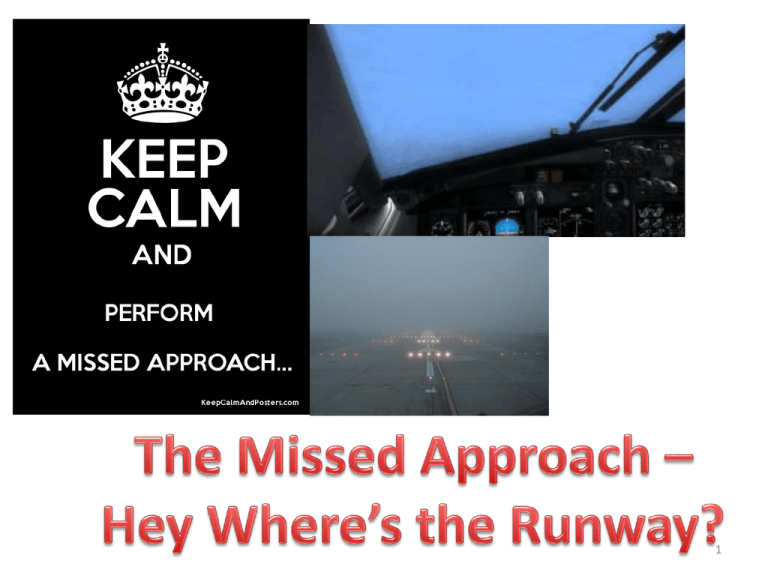Missed Approach Procedures - Bob`s Flight Operations Pages
advertisement

1 Missed Approach Segment • A Missed approach is a procedure used when an instrument approach cannot be completed to a full-stop landing • The Missed Approach Segment is that part of an instrument approach procedure between the missed approach point (MAP), the missed approach way-point (MAWP), or the point of arrival at the decision height and the specified missed approach NAVAID (navigational aid), intersection, fix, or waypoint, as appropriate, at the minimum IFR altitude – It is in this part of the approach procedure that the aircraft will climb and return to the en route structure or is positioned for holding or subsequent approach – The missed approach route and altitudes are shown on the instrument approach charts 2 The Missed Approach • The missed approach is one of the most difficult and critical phases of an instrument approach and is the one practiced the least – High workload, as the configuration of the aircraft must be changed (approach to climb out), coupled with new navigation route/Navaids – An approach in actual conditions should be flown with the anticipation that the missed approach is an anticipated outcome • The missed approach procedure typically includes an initial heading or track to follow, and an altitude to climb to. This is typically followed by holding instructions at a nearby navigation fix • Be sure you have reviewed the missed approach procedure BEFORE the FAF 3 Missed Approach Anatomy Start of climb 4 How Did We Get to a Missed Approach FAR 91.175(e) • A missed approach procedure must be immediately executed: – 1. Whenever: • Flight visibility is less than the specified visibility for the approach • If required visual references are not seen at either of the following times: – When the aircraft is being operated below MDA; or – Upon arrival at the missed approach point, including a DA/DH where a DA/DH is specified and its use is required, and at any time after that until touchdown. – 2. Whenever an identifiable part of the airport is not distinctly visible to the pilot during a circling maneuver at or above MDA, unless the inability to see an identifiable part of the airport results only from a normal bank of the aircraft during the circling approach 5 Visual References FAR 91.175(c)(3) • • Except for certain Category II or III approaches, at least one of the following visual references for the intended runway must be distinctly visible and identifiable to the pilot to continue below the DH or MDA: – The approach light system, except you may not descend below 100 feet above the touchdown zone elevation using the approach lights as a reference unless the red terminating bars or the red side row bars are also distinctly visible and identifiable – The threshold – The threshold markings – The visual approach slope indicator – The threshold lights – The runway end identifier lights (REIL) – The touchdown zone or touchdown zone markings – The touchdown zone lights – The runway or runway markings – The runway lights Basic rule of thumb you need to distinctly see the runway and/or its lighting 6 Also Go Missed If: • • • • A safe approach or landing is not possible Full scale needle deflection past the final approach fix Navigation equipment required for the approach fails ATC instructs you to go missed – Unsafe runway – Traffic – Controller or pilot navigation errors • Weather – e.g., thunderstorm cell • When the aircraft is being operated below MDA – loss of visual references • If your gut says something is wrong or unclear 7 Missed Approach Clearance • A clearance for an instrument approach procedure includes a clearance to fly the published missed approach procedure, absent contrary ATC instructions 8 Missed Approach Procedures • Published Missed Approach Instructions – If ATC has not issued specific instructions prior to the approach and a missed approach is executed, the pilot must follow the published or default missed approach procedure – A controller may issue modified instructions, which supersede the published instructions • Verbal Missed Approach Instructions – ATC may give you instructions for the missed approach prior to the clearance for the approach • ATC will give you altitude, heading, frequency, and supplementary information as required – ATC: "Missed approach instructions, climb [Altitude], turn left [Heading] and contact departure [Frequency]. Be advised [Traffic...]“ • If executing instructions different from those on the procedure as dictated by approach, call “on the go" or "executing climb out" to reduce confusion 9 Missed Approach Chart Symbols • To provide ready missed approach guidance, approach plates use quick reference icons – Due to limited space only four or less icons can be shown. Hence the icons may not show the entire missed approach procedure – The full missed approach instructions are provided textually at the top of the approach chart in the pilot briefing 10 JEPP Missed Approach Chart Symbols 11 NACO Missed Approach Chart Symbols Climb to altitude Turn to specified heading Track Radial To Specified fix 12 Missed Approach Point Location • The missed approach point (MAP) on a non-precision approach is not designed with any consideration to where the aircraft must begin descent to execute a safe landing – It is developed based on terrain, obstructions, NAVAID location and possibly air traffic considerations – Descent below the MDA, including during the missed approach, is not authorized • The Decision Altitude (DA) is an altitude derived location where a missed approach will be initiated on a precision approach – Obstacle clearance is provided to allow a momentary descent below DA while transitioning from the final approach to the missed approach – Decision Altitude (DA) replaces the familiar term Decision Height (DH). 13 Obstacle Protection • Obstacle protection is predicated on the missed approach being initiated at the DA/H or at the missed approach point and not lower than minimum descent altitude (MDA) • A climb gradient of at least 200 feet per nautical mile is required, unless a higher climb gradient is published in the notes section of the approach procedure chart – When higher than standard climb gradients are specified, the end point of the non-standard climb will be specified at either an altitude or a fix • Preplan your approach to ensure you can meet the climb gradient (expressed in feet per nautical mile) – Higher than anticipated ground speed increases the climb rate requirement (feet per minute) – Tables for climb gradients (feet per nautical mile) to climb rate (feet per minute), based on ground speed, are on page D1 of U.S. Terminal Procedures booklets – Formula: Required Climb Per Minute = ((_[climb gradient]_ ft/nautical mile) x ([ground speed] nautical miles/hour)/60) = 36,000 feet per hour = 14 Beginning the Procedure Other Than at the MAP/DH • In the design of the missed approach procedure no consideration is given to an abnormally early missed approach turn from the approach course • When an early missed approach is executed, pilots should, unless otherwise cleared by ATC, – Fly the IAP as specified on the approach plate to the missed approach point – Remain at or above the MDA or DH before executing a turning maneuver – Can begin climb early, absent altitude restrictions • Think CFIT when making an early missed!! 15 Circling Approach MAP • Executing the missed approach after starting the circling maneuver usually places the aircraft beyond the MAP • The missed approach is executed for the runway the approach started on, not the runway you were circling to • The initial turn on a missed approach will always be towards the landing runway until established on a segment of the missed approach • Always think about how to execute the missed approach while circling so it is not a surprise if you enter IMC as aircraft is clear of obstacles only when at or above the MDA while inside the circling area Since the circling missed approach maneuver may be accomplished in more than one direction, different patterns will be required to become established on the prescribed missed approach course, depending on the aircraft position at the time visual reference is lost. 16 Flying the Missed Approach • Before the FAF – Memorize initial altitudes and headings – Set up No. 2 Nav if possible for missed approach initial navaid course 17 Flying the Missed Approach Initial Missed Approach Segment Procedure • At the MAP / DA – Add climb power – Rotate gradually (on-speed) to Vx – Check for positive rate of climb – Clean up the aircraft – gear and flaps up in the order specified by the POH – Climb out at appropriate speed 18 Communicate • Upon execution of a missed approach and becoming stabilized in climb notify ATC – If communicating with the Tower - "[Place] tower, [Callsign], missed approach [Reason]" – If communicating with approach - "[Place] approach, [Callsign] missed approach off of [Location] climbing through [Altitude] for [Altitude] with request" 19 Lost Communications Missed Approach • • If communications are lost during the approach and you take a missed approach: – Squawk 7600 – Follow the published missed approach instructions to ensure adequate obstruction clearance – Route: • Proceed to the alternate IAF as filed and commence an approach – Altitude: • The EXPECTED altitude, if given one, after filing a “DRAFT” or; • Your option of the highest of the two emergency safe altitudes depicted on the destination and alternate approach procedure charts if fields are within 200 NM of each other or • At flight level 18,000' – If destination altimeter is 29.92 inches or higher, fly FL180 – If destination altimeter is less than 29.92, fly FL190 "DRAFT": Short flight plan including - a) Destination; b) Route; c) Altitude; d) Fuel State and e) Time En-route 20 NOW WHAT • Decide what your course of action will be – Repeat the same approach at the same airport – Another approach at the same airport – Divert to planned alternate – Divert elsewhere – Hold for conditions to improve • Consider fuel load and distance / time to a good alternate • Inform ATC of your desires 21 Alternate Missed Approach • • Some locations may have a preplanned alternate missed approach procedure for use in the event the primary NAVAID used for the missed approach procedure is out of service To avoid confusion, the alternate missed approach instructions are not published on the chart – • • However, the alternate missed approach holding pattern will be depicted on the instrument approach chart When the alternate missed approach procedure is implemented by NOTAM, it becomes a mandatory part of the procedure. The NOTAM will specify both the textual instructions and any additional equipment requirements necessary to complete the procedure You may reject an ATC clearance for an alternate missed approach that requires equipment not necessary for the published approach procedure when the alternate missed approach is issued after beginning the approach – However, if the alternate missed approach is issued prior to beginning the approach the pilot must either accept the entire procedure (including the alternate missed approach) or request a different approach procedure 22 G1000 Missed Approach • At the MAP, “SUSP” is displayed in the HSI and directly above the SUSP softkey – Automatic sequencing of approach waypoints is suspended at the MAP – A “FROM” indication is displayed on the CDI, but the course guidance is simply an extension of the final approach course • Do NOT follow this extended course • When the message “RAIM is not available” is displayed in the Alerts Window on the PFD a missed approach must also be executed 23 G1000 Missed Approach • Flying the Missed – Initiate the missed approach sequence by following the missed approach procedures as published / directed by ATC, for proper climb and heading instructions – If not already using GPS as nav source, press the CDI softkey to switch external CDI output to GPS for guidance. – Press the SUSP softkey to return to automatic sequencing of waypoints – If there is a missed approach course from a fix to altitude, Within a few seconds of pressing the SUSP softkey , “SUSP” is re-displayed above the SUSP softkey • Upon reaching the desired altitude, press the SUSP softkey to resume automatic leg sequencing • After pushing SUSP, “NEXT DTK 123” message is displayed in the navigation status bar on the PFD – The G1000 will guide to the missed approach holding point and a recommended entry procedures for the holding pattern will be shown 24 G1000 Missed Approach • Note that the G1000 at the holding point again displays “SUSP” above the SUSP softkey. Automatic waypoint sequencing is suspended at the missed approach holding point. The waypoint message (ARRIVING AT WAYPOINT) is displayed each time the plane approaches the holding fix in the holding pattern • The G1000 provides course guidance only on the inbound side of the holding pattern – When leaving the holding pattern to re-fly the approach, press the PROC key to “Select Approach” or “Activate Approach” (or use the Direct-To key to select another destination) 25 G1000 Missed Approach Example Missed Approach Course From Fix To Altitude – – – – – – – – – After pressing the SUSP softkey, the missed approach sequence is automatically started with the course from fix to altitude leg After pushing SUSP, “NEXT DTK 123” message is displayed in the navigation status bar on the PFD Within a few seconds of pressing the SUSP softkey , “SUSP” is re-displayed above the SUSP softkey The G1000 returns to suspend mode when flying a course from a fix to altitude leg and indicates that automatic leg sequencing is suspended Fly the outbound course keeping the CDI needle centered. The Navigation Map Page depicts the flight path extending indefinitely from the Navfix. The distance increases and indicates the distance back to the Navaid Upon reaching the desired altitude, press the SUSP softkey to return to automatic leg sequencing. Confirm that ‘SUSP’ no longer is displayed directly above the SUSP softkey The message “NEXT DTK 123” is the displayed, providing guidance to the holding fix. The actual desired track (DTK) depends on the ground speed and distance from the Navaid. Intercept and fly the inbound course, keeping the CDI needle centered As the plane approaches the Navaid (the missed approach holding point), a message in the navigation status bar recommends the holding pattern entry, e.g., “HOLD PARALLEL” Note that the G1000 again displays ‘SUSP’ above the SUSP softkey. Automatic waypoint sequencing is suspended at the missed approach holding point. The waypoint message (ARRIVING AT WAYPOINT) is displayed each time the plane approaches the holding fix in the holding pattern When leaving the holding pattern, press the PROC key to reactivate the approach or select a different approach, or press the Direct-To key to select another destination 26 G1000 Missed Approach Additional Automation • GA Switch (Go-Around) – – – – Disengages the autopilot Selects the flight director Go-Around Mode, and Activates the missed approach The GA Switch is located on the instrument panel above the throttle • TOGA (Takeoff/Go-Around) Switch – Offers automated go-arounds – At the MAP, press the TOGA button • • • • Keeps the AP engaged Commands a climb Sets Autopilot to NAV mode and Sequences to the missed approach 27 Pitch-up Illusion • Pitch-up illusion is a significant hazard during the transition to climb out • On approach the portion of the inner ear that provides sensory information related to acceleration—provides the sensation of stabilized speed, based primarily on the forces of gravity • When acceleration and climb occur simultaneously as during the initial segment of a missed approach, two forces come together - gravity and acceleration • The brain resolves the two forces (gravity and acceleration) as a single resultant force acting downward and backward. The brain incorrectly resolves the two forces as a single pitch-up movement • When that occurs, the pilot feels as though the aircraft is climbing or that the nose is pitching up, when, in fact, it remains in level flight. • The normal reaction, absent visual clues, to the pitch-up illusion is to push forward on the stick with the risk of ground contact in a missed approach 28 Common Errors • Failure to have essential knowledge of the information on the approach chart • Failure to have initial steps of missed approach committed to memory • Failure to identify DH or MAP or other condition requiring a missed approach • Incorrect communication procedures • Noncompliance with ATC clearances, the published missed approach or an ATC instruction or failure to notify ATC of inability to comply • Failure to accomplish checklist items • Faulty basic instrument flying techniques • Failure to accomplished a missed approach timely – e.g. motoring on to look for references 29 PTS Standards Area of Operation VI. C. • Executes the missed approach procedure when the required visual references for the intended runway are not distinctly visible and identifiable: – Non-Precision Approach – at the MAP – Precision Approach - at Decision Altitude 30 PTS Standards Area of Operation VI. C. • • • • • • • • • • Adequate knowledge of the missed approach procedure elements for standard approaches Initiates the missed approach promptly by applying power, establishing a climb attitude, and reducing drag in accordance with the aircraft manufacturer’s recommendations Reports beginning the missed approach procedure to ATC Complies with the published or alternate missed approach procedure Advises ATC or examiner anytime that the aircraft is unable to comply with a clearance, restriction, or climb gradient Follows the recommended checklist items appropriate to the go-around procedure Requests, if appropriate, ATC clearance to the alternate airport, clearance limit, or as directed by the examiner Maintains the recommended airspeed within ±10 knots; heading, course, or bearing within ±10°; and altitude(s) within ±100 feet during the missed approach procedure. Uses MFD and other graphical navigation displays, if installed, to monitor position and track to help navigate the missed approach. Demonstrates an appropriate level of single-pilot resource management skills. 31 Questions 32 Disclaimer • Instrument flight can be dangerous. Do not rely solely on this presentation – PROFESSIONAL INSTRUCTION IS REQUIRED • The foregoing material should not be relied upon for flight. • ALTHOUGH THE ABOVE INFORMATION IS FROM SOURCES BELIEVED TO BE RELIABLE SUCH INFORMATION HAS NOT BEEN VERIFIED, AND NO EXPRESS REPRESENTATION IS MADE NOR IS ANY TO BE IMPLIED AS TO THE ACCURACY THEREOF, AND IT IS SUBMITTED SUBJECT TO ERRORS, OMISSIONS, CHANGE. 33






